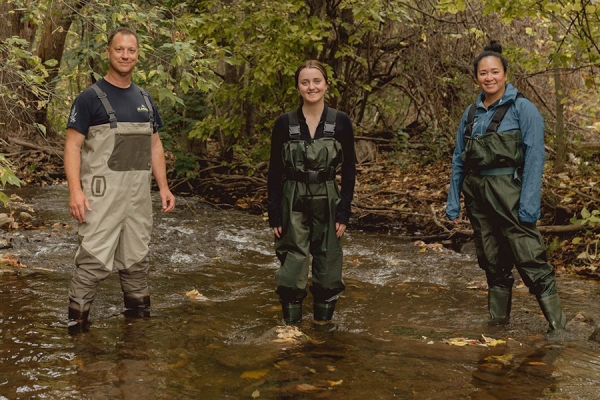 Trevor Pitcher, student Bri Curtis, and Catherine Febria stand in a stream in the Greater Toronto Area home to the redside dace. Photo by Shayenna Nolan.
Trevor Pitcher, student Bri Curtis, and Catherine Febria stand in a stream in the Greater Toronto Area home to the redside dace. Photo by Shayenna Nolan.
There are species of freshwater fish and mussels disappearing from the Great Lakes, but University of Windsor researchers and colleagues are working to reverse the biodiversity decline.
A project entitled “Application and Assessment of Recovery Actions for Species at Risk Fishes and Mussels in the Lower Great Lakes” aims to develop a better understanding of habitat needs and threats, to restore habitat, and to captively breed imperilled species.
“Freshwater biodiversity declining quickly: this is raising alarm bells and they refer to this as ‘the invisible collapse’ because it receives much less attention than biodiversity loss in the oceans,” says Trevor Pitcher, lead researcher on the project and professor and researcher with the Department of Integrative Biology and the Great Lakes Institute for Environmental Research (GLIER).
“These are at-risk freshwater fish and mussels that few people study — especially in the context of habitat loss and captive breeding — and we want to change that.”
The four-year project received funding totalling $850,000 from the Department of Fisheries and Oceans’ Canada Nature Fund for Aquatic Species at Risk and partners: McGill University, University of Toronto, St. Clair Region Conservation Authority, and Ausable-Bayfield Conservation Authority.
The project will focus on four major conservation aspects:
- Study habitat needs and restore critical habitat for several species at risk
- Examine stressors such as road salt, thermal stress, turbidity, and hypoxia
- Develop captive breeding methods for endangered species
- Examine the effectiveness of previous conservation efforts (e.g translocations of at-risk mussels)
The team will identify areas within the Lower Great Lakes watershed, known to have 47 endangered or threatened fish and mussel species in a variety of habitats.
“As is the case for many species at risk, the primary threat to many of these species is habitat degradation and loss,” Dr. Pitcher says.
“For successful recovery actions related to this threat, for each species at risk, the habitat requirements and nature of the habitat threat must be understood, and suitable habitat and the species at risk must be present.”
Pitcher and his colleague Catherine Febria will work in the field and take some species back to the lab to work on examining stressors. Understanding the tolerances of the species at risk will help inform the restoration of the habitat.
Once areas are identified and the stressors are understood, the partnering conservation authorities will focus on habitat restoration, including cleaning up marshlands, planting to reduce soil erosion, and soft engineering the banks.
Finally, the team will provide tools to breed in captivity and potentially reintroduce species that have already disappeared. Pitcher will focus on breeding at-risk redside dace and spotted gar. The captive fish breeding will be done at the Freshwater Restoration Ecology Centre.
Dr. Febria, director of the Healthy Headwaters Lab, is focusing on mussel species kidneyshell, northern riffle shell, and snuffbox, which are at risk in the Sydenham River watershed in southwestern Ontario.
“The Sydenham River is home to the largest diversity of freshwater mussels and also has a large number of them that are at risk of extinction,” says Febria.
“Freshwater mussel species are a keystone group that depend on co-ordinated restoration not only within the stream but across a whole watershed.”
Febria’s team will work in close partnership with St. Clair Region Conservation Authority and Fisheries and Oceans Canada to assess the distribution of mussel species at risk and their connection with their habitats, fish, and other invertebrates.
“Advancing research to inform conservation and restoration efforts are therefore critical. We are grateful for a further four years of funding that will allow us to explore the role of community science and accelerate conservation efforts on the ground based on our research findings.”
